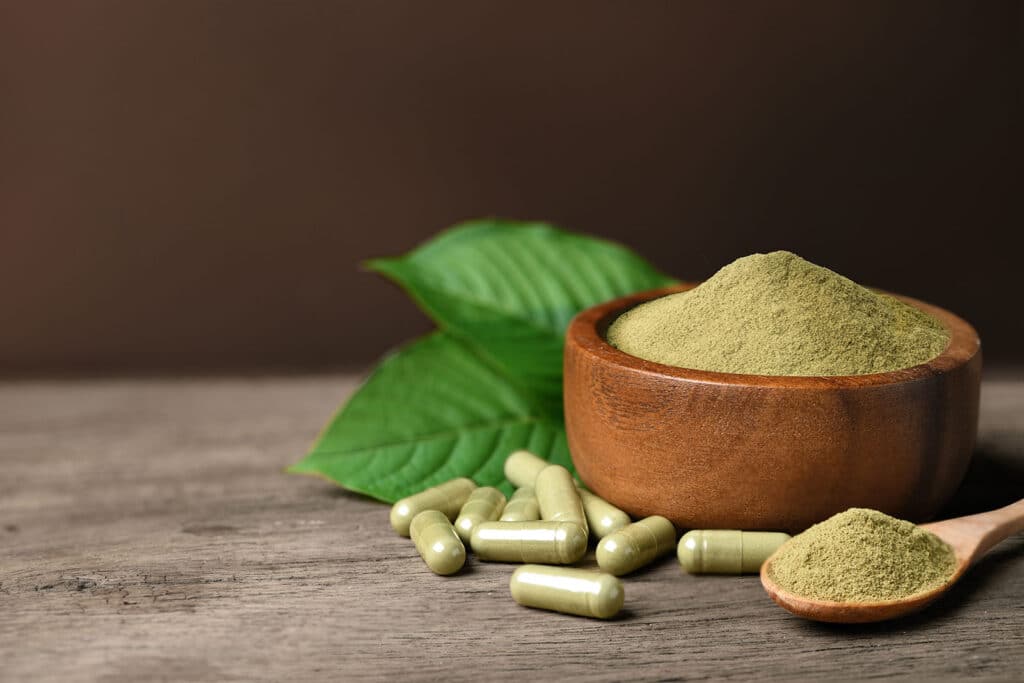To many people, Long Island was considered ground zero for dangerous opioid addictions. But is kratom among those prevailing problems? Is it even an opioid?
If it does cause an addiction, how can it be treated or prevented? This guide answers these questions and more, backed by proven studies and statistics.
Table of Contents
Kratom Addiction: An Overview
Kratom, or Mitragyna speciosa, is a tree native to the southeastern region of Asia. The chemical in the leaves, mitragynine, is a potent pain killer, which is why kratom can be used for pain relief.
However, despite not being an opioid, it can still cause addiction. To understand how this happens, we need to look at our bodies’ norm of activating opioid receptors.
Our brains are equipped with neurotransmitters (messengers) and receptors. Naturally, our bodies release endogenous opioids which are the neurotransmitters responsible for emotional regulation.
When these opioids bind to their respective receptors, they regulate emotions like happiness, relaxation, and reward.
Exogenous opioids, however, compete with the endogenous ones over the opioid receptors in the nervous system.
Chronic use of exogenous opioids can flood these receptors, making it harder for the body’s own opioids to bind and exert their effects on pain perception, mood, and reward.
Further, the excessive presence of exogenous receptors can cause negative feedback to the brain. Negative feedback is a phenomenon where the body signals to the brain that it’s already saturated with a certain hormone or a neurotransmitter.
The brain responds by reducing the secretion of such neurotransmitters to maintain equilibrium. That’s how kratom dependence occurs.
Despite not being an opioid, kratom still partially activates the opioid receptors, leading to a less-probable but possible addiction.

Signs and Symptoms of Kratom Addiction
The following signs and symptoms may be present completely or partially. They can help identify that a person is struggling with kratom dependence.
Unfortunately, kratom doesn’t show up on the standard 5-panel drug test, making it best to leave the definitive diagnosis to a qualified clinician. The diagnostic criteria that the clinician may notice can either be mental or physical.
Mental Effects of Kratom Addiction
Here’s how kratom can mentally affect a person:
- Mild, moderate, or severe kratom cravings.
- Neglecting one’s responsibilities at home and work.
- Decreased overall productivity.
- Losing interest in social activities.
- Continuing to use kratom while fully aware of its issues.
- More susceptibility to starting fights and exercising irrational behavior.
- Depression and anxiety.
Physical Effects of Kratom Addiction
Here’s how kratom can physically affect a person:
- Upset stomach.
- Hot or cold flashes.
- Restless legs.
- Runny nose.
- Slowly acquiring tolerance to the drug.
- Nausea and vomiting.
- Daytime sleepiness.
- Exhaustion and lack of energy.
- Body aches.
- Inability to sleep at night.
Kratom’s Withdrawal Symptoms
Much like opioids, kratom can cause withdrawal symptoms once the struggling person stops taking it, making it harder to quit despite multiple attempts.
That’s because the main kratom components, mitragynine, and 7-hydroxy mitragynine, can partially activate the same receptors that opioids activate.
Kratom withdrawal symptoms appear 12–48 hours after stopping kratom use. They typically last 1–3 days, but in extreme addiction cases, they may last up to a week. They include but aren’t limited to:
- Irrational aggression.
- Muscle aches and twitching.
- Excessive cravings.
- Emotional outbursts.
- Irritability and restlessness.
- Joint stiffness.
- Diarrhea.
- Mood swings.
Keep in mind that, unlike primary opioids that fully activate brain receptors, kratom partially activates them. Partial activation still makes it addictive, but less potent compared to opioids like morphine and heroin.
This partial activation is why some people try to self-treat themselves from opioid addiction by using kratom, according to studies.
However, because of a great deal of debate over its safety, it’s often safer to use drugs like naltrexone (under professional supervision) for opioid addiction.
Naltrexone is a partial agonist that binds to the opioid receptors without activating them, making it theoretically non-addictive.
Is Kratom Addiction Common in Long Island?
Kratom addiction in Long Island isn’t as common as opioids. According to the results from the 2020 National Survey on Drug Use and Health, only 1% of people over 12 years old in the US used Kratom in 2020.
There are currently no solid statistics regarding the prevalence of its misuse in Long Island per se. Yet, Nationwide and according to the CDC, 152 out of 30,000 drug overdose fatalities between July 2016 and December 2017 tested positive for kratom.
In other words, Kratom may not be strongly addictive, but it can still be lethal. That’s why, according to a 2021 study, the Drug Enforcement Agency considers kratom a rising concern.
Kratom Addiction Treatment in Long Island
Any drug that causes addiction is best treated using an addiction recovery program. Look for well-established and highly trusted treatment centers like the Long Island Addiction Treatment Center.
Depending on the duration and the severity of the addiction, treatment may range from telehealth services and outpatient programs to 24-hour supervised clinical care within the premises of the treatment center.
Generally, there are four stages to recovering from kratom addiction:
1. Drug Detoxification
Drug detox is abstaining from using the addictive drug until it’s no longer present in the body. Mild to moderate detoxifications can occur without professional help, as the withdrawal symptoms aren’t as severe.
However, severe addiction requires a controlled, medically supervised environment within the recovery center.
If the addiction is severe, gradually reducing the struggling person’s daily dose (gradual detox) is applied to reduce the severity of withdrawal symptoms.
2. Supplemental Medication
Supplemental medications can be used during the detox to help with the withdrawal symptoms. Other medications are used after the process to reduce post-detox cravings.
Dihydrocodeine and lofexidine are among the common drugs used to help with withdrawal symptoms.
After the withdrawal period, naltrexone and buprenorphine can be used. They are partial agonists to reduce the euphoric effect achieved after ingesting a drug, discouraging the recovering person from using kratom and thus, potentially reducing the cravings.
3. Psychological Rehabilitation
Physical dependence is addressed through the detox stage. However, psychological dependence on the addictive drug takes longer to treat, and it differs from person to person.
Psychological rehabilitation involves therapy sessions where the recovering person is led to understand why the addiction started, to begin with. They are also taught about the triggers that may lead to cravings to help them avoid or at least reduce these cravings as much as possible.
Support groups are also common aspects of post-detox rehabilitation, as they keep the recovering person within a group of people with similar struggles, making them feel that they’re not fighting alone.
Psychological rehabilitation can be done inside or outside the treatment center. This often depends on the recovery rate and willingness of the recovering person to cooperate.
4. Post-treatment Care
A 2023 study found that over 41.1 million people required addiction treatment in 2020 and that 40%–60% of them relapsed within the first year of recovery. That’s between 16,000,000 and 24,000,000 cases requiring treatment all over again.
Another 2013 study discovered that 85% of cases relapse within the first year.
These statistics show how terrifying psychological dependence and the lack of post-treatment care can be in relapse.
A reliable post-treatment care program will teach recovering people vital aspects of dealing with addiction. These include:
- How to identify and avoid potential triggers.
- How and when to seek help when the cravings build up.
- How to utilize telehealth services when the treatment center is physically inaccessible (in case of traveling).
- How to find useful habits and life goals to maintain sobriety.
- How to maintain contact with recovering peers to provide mutual support.
- How to readjust and cope with life pressures that potentially caused the addiction to start.
Aftercare programs are often tailored to individual needs. Recovering people must not be afraid to report that cravings are still present. It doesn’t show any weakness, it only shows honesty and determination to overcome the addiction.
FAQs
Is Kratom Legal in the United States?
Kratom is legal in some states like New York, Massachusetts, Maine, Maryland, and Kentucky. Yet, it’s illegal in others like Alabama, Arkansas, Indiana, and Tennessee.
Can You Overdose on Kratom?
Yes. Although quite rare, it is possible to overdose on kratom. According to the same CDC report listed earlier, 91 out of the 152 fatalities that abused kratom have overdosed on the drug.
How Long Does it Take to Treat Kratom Addiction?
It takes up to 48 hours to fully detox kratom from the bloodstream. It may then take up to a week to handle the withdrawal symptoms. As for the psychological dependence, it may take weeks to months to recover. This highly depends on individual cases.
Wrap Up
Kratom may not be as addictive as opioids, but it’s still addictive and potentially lethal. Despite being legal in many states, the drug is to be handled with care.
If you or a loved one senses that you’re developing any of the addiction symptoms mentioned in this guide, reaching out to a doctor is paramount.

